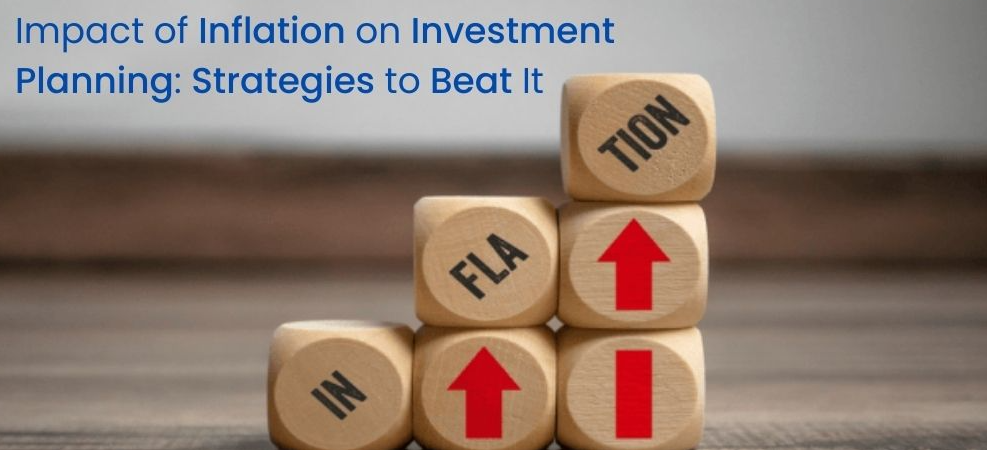
The Silent Wealth Eroder: Understanding The Role of Inflation in Investment Returns
Imagine you have a crisp $100 bill today. Now imagine holding onto that same $100 bill for 20 years. Will it buy the same amount of groceries, pay for the same dinner, or fill your gas tank as much in two decades as it does today? The answer, for most of us, is a resounding no. This shrinking power of money over time is the core concept of inflation, and it plays a massive – often underestimated – role in your investment returns.
For beginner investors, understanding inflation isn’t just an economic theory; it’s a crucial piece of the puzzle for building lasting wealth. It determines whether your investments are truly growing your purchasing power or just running in place.
Let’s dive deep into how inflation impacts your hard-earned money and what you can do about it.
What Exactly Is Inflation? A Beginner’s Guide
Before we talk about investments, let’s make sure we’re clear on inflation itself.
In simple terms, inflation is the rate at which the general level of prices for goods and services is rising, and consequently, the purchasing power of currency is falling.
Think of it like this:
- Your Money’s Value Shrinks: If a loaf of bread costs $2 today and inflation is 5%, next year that same loaf might cost $2.10. Your $2 from last year buys less bread this year.
- The "Basket of Goods": Economists often talk about a "basket of goods and services" that a typical household buys (food, housing, transportation, healthcare, etc.). When the cost of this basket goes up, you have inflation.
Why does it matter for investors? Because your investments are designed to make your money grow. But if that growth doesn’t outpace inflation, you’re not actually getting richer in terms of what your money can buy.
The Crucial Difference: Nominal vs. Real Returns
This is perhaps the single most important concept to grasp when linking inflation and investments.
- Nominal Return: This is the return you see on your investment statement. It’s the raw percentage gain before accounting for inflation. If your stock portfolio grew by 8% last year, 8% is your nominal return.
- Real Return: This is your actual return after accounting for the eroding effect of inflation. It tells you how much your purchasing power has truly increased.
The Simple Formula:
Real Return = Nominal Return – Inflation Rate
Let’s look at an example:
-
Scenario 1: Good Times
- Your Investment’s Nominal Return: +10%
- Inflation Rate: +3%
- Your Real Return: 10% – 3% = +7% (Your money truly grew in purchasing power!)
-
Scenario 2: Breaking Even (or Worse!)
- Your Investment’s Nominal Return: +5%
- Inflation Rate: +5%
- Your Real Return: 5% – 5% = 0% (You made money on paper, but you can’t buy anything more than you could before.)
-
Scenario 3: Losing Ground
- Your Investment’s Nominal Return: +2%
- Inflation Rate: +4%
- Your Real Return: 2% – 4% = -2% (Despite seeing a positive number on your statement, your money actually lost purchasing power.)
Key Takeaway: Always focus on your real return. It’s the true measure of your wealth growth over time.
How Inflation Impacts Different Investment Types
Inflation doesn’t treat all investments equally. Some asset classes are more vulnerable, while others can act as potential hedges.
1. Cash and Savings Accounts
- Impact: Most vulnerable.
- Why: The interest rates offered on traditional savings accounts and money market funds are often very low, frequently below the rate of inflation. This means your cash is almost guaranteed to lose purchasing power over time.
- Example: If you have $10,000 in a savings account earning 0.5% interest, and inflation is 3%, your real return is -2.5%. You’re effectively losing $250 in purchasing power each year.
- Role in Portfolio: Essential for emergencies (liquidity), but not for long-term wealth growth.
2. Bonds (Fixed Income)
- Impact: Generally negative, especially for long-term bonds.
- Why: Bonds pay a fixed interest rate (coupon payment) over a set period. When inflation rises, those fixed payments become less valuable in real terms. The purchasing power of both the interest payments and the principal (the original amount returned at maturity) erodes.
- Example: You buy a bond paying 3% interest. If inflation rises to 5%, your real return is -2%.
- Exception: Treasury Inflation-Protected Securities (TIPS):
- What they are: These are special U.S. government bonds designed to protect investors from inflation.
- How they work: The principal value of a TIPS adjusts with the Consumer Price Index (CPI), a common measure of inflation. If inflation rises, the principal increases, and so do the interest payments (which are a fixed percentage of the adjusted principal).
- Role in Portfolio: Can be a good way to hedge against inflation, especially in an environment where inflation is expected to rise.
3. Stocks (Equities)
- Impact: Mixed, but often perform well over the long term.
- Why:
- Positive: Companies can (and often do) raise the prices of their products and services to offset rising costs. This "pricing power" allows them to maintain or even grow their profits, which can translate into higher stock prices and dividends.
- Negative: Inflation also increases a company’s costs (raw materials, labor, transportation). Companies without strong pricing power may see their profit margins squeezed, hurting their stock performance.
- Growth vs. Value: High-growth stocks (whose value relies heavily on future earnings) can sometimes be hurt by inflation if it leads to higher interest rates, which discount those future earnings more heavily. "Value" stocks (companies with strong current earnings and assets) might fare better.
- Long-Term View: Historically, stocks have been one of the best asset classes for outpacing inflation over the long run, as businesses adapt and grow with the economy.
4. Real Estate
- Impact: Generally positive, often considered an inflation hedge.
- Why:
- Rising Values: As the cost of building new properties increases due to inflation (labor, materials), the value of existing properties tends to rise.
- Rising Rents: Landlords can typically increase rents in line with inflation, generating more income.
- Fixed Mortgages: If you have a fixed-rate mortgage, your monthly payment stays the same while the value of the property and potential rental income increases, effectively reducing your real debt burden over time.
- Considerations: Real estate is illiquid (hard to sell quickly), and rising interest rates (often a response to inflation) can make mortgages more expensive, cooling the market.
5. Commodities
- Impact: Directly linked to inflation, often considered a strong inflation hedge.
- Why: Commodities are raw materials (oil, gold, silver, copper, agricultural products like corn or wheat). Their prices often rise directly with inflation, as they are the inputs for most goods and services.
- Examples:
- Gold: Often seen as a traditional "safe haven" against inflation and economic uncertainty because it tends to hold its value when currencies devalue.
- Oil & Gas: Energy prices are a major component of inflation.
- Considerations: Commodities can be very volatile and don’t generate income like stocks (dividends) or bonds (interest).
Strategies to Mitigate Inflation’s Impact on Your Portfolio
Now that you understand how inflation works, what can you do to protect your investments and ensure your money keeps its purchasing power?
-
Prioritize Real Returns:
- Action: Always calculate your real return, not just the nominal one. This helps you understand if your investments are truly making you wealthier.
- Why it helps: Keeps your focus on your true financial progress.
-
Diversify Your Portfolio:
- Action: Don’t put all your eggs in one basket. Spread your investments across different asset classes (stocks, bonds, real estate, commodities).
- Why it helps: Different assets perform differently in various economic conditions. A well-diversified portfolio helps cushion the blow if one asset class struggles with inflation.
-
Consider Inflation-Protected Securities (TIPS):
- Action: Allocate a portion of your fixed-income portfolio to TIPS, especially if you’re concerned about rising inflation.
- Why it helps: They are specifically designed to preserve your purchasing power in an inflationary environment.
-
Invest in Companies with "Pricing Power":
- Action: When investing in stocks, look for companies that have strong brands, unique products, or dominant market positions. These companies are better able to pass on their rising costs to customers without losing significant sales.
- Why it helps: Their profit margins are more resilient to inflationary pressures. Examples include essential goods providers, strong consumer brands, or technology leaders.
-
Explore Real Estate or REITs:
- Action: Consider investing in physical real estate (if suitable for your situation) or Real Estate Investment Trusts (REITs). REITs are companies that own, operate, or finance income-producing real estate and trade like stocks on exchanges.
- Why it helps: Real estate can act as a long-term hedge against inflation due to rising property values and rental income.
-
Don’t Overlook Commodities (with Caution):
- Action: A small allocation to broad commodity funds or specific commodities like gold can offer some inflation protection.
- Why it helps: Their prices often rise directly with inflation.
- Caution: Commodities are volatile and can be risky. Understand their nature before investing.
-
Maintain a Long-Term Perspective:
- Action: Don’t panic and make rash decisions based on short-term inflation spikes. Focus on your long-term financial goals.
- Why it helps: Over many decades, well-chosen investments (especially stocks) have historically outpaced inflation. Compounding works wonders over time, even with inflation in the background.
The Investor’s Mindset in an Inflated World
Inflation is a constant economic force, not a temporary blip. As an investor, adopting the right mindset is key:
- Be Aware, Not Afraid: Understand inflation’s impact, but don’t let it paralyze your investment decisions.
- Focus on Growth: Your goal isn’t just to make money, but to make your money grow faster than the cost of living.
- Stay Educated: Economic conditions change. Keep learning about how inflation is behaving and what it means for your portfolio.
- Review Regularly: Periodically review your investment strategy to ensure it aligns with current inflation trends and your financial goals.
Conclusion: Empowering Your Investments Against Inflation
Inflation is the silent tax on your money. It erodes your purchasing power, making your future self poorer if you don’t account for it. For beginners, understanding the difference between nominal and real returns is the first, most critical step.
By strategically diversifying your portfolio, considering inflation-protected assets, and investing in resilient businesses, you can significantly mitigate the negative effects of inflation. Remember, the goal isn’t just to accumulate more dollars, but to ensure those dollars can buy you more of what you need and desire in the future. Armed with this knowledge, you are better equipped to build a truly robust and inflation-resistant investment portfolio.



Post Comment